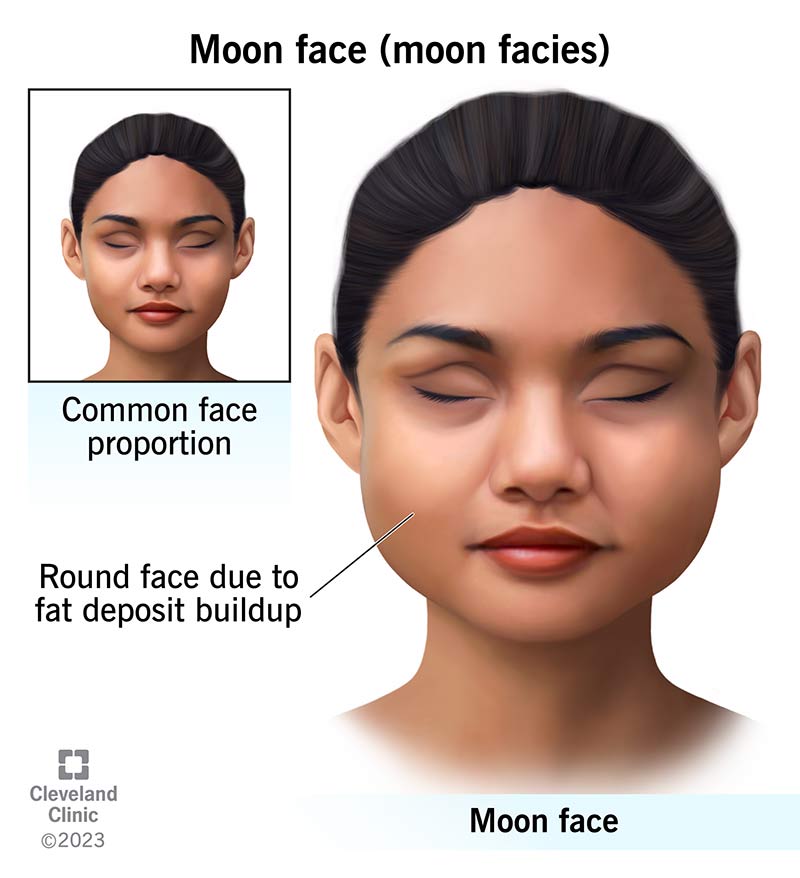Moon face is when fat deposits build up along the sides of your face, causing severe swelling. The swelling can make your face look round and puffy. Moon face is a common side effect of corticosteroid use and a symptom of certain health conditions. Although harmless, the condition can affect your self-esteem. The medical term for this is moon facies, but other people call it cortisol face.
Advertisement
Cleveland Clinic is a non-profit academic medical center. Advertising on our site helps support our mission. We do not endorse non-Cleveland Clinic products or services. Policy

Moon face is swelling that builds up on the sides of your face, making it look puffy and round, like a full moon. The buildup of fat deposits in the side of your skull can make your face so round that you can’t see your ears from the front. The medical term for moon face is moon facies. Some people call it cortisol face.
Advertisement
Cleveland Clinic is a non-profit academic medical center. Advertising on our site helps support our mission. We do not endorse non-Cleveland Clinic products or services. Policy
Using steroid medication like prednisone for a long time is often the cause. But it can also be a sign of a health condition like Cushing’s syndrome or hypothyroidism.
Moon face usually isn’t painful or dangerous. But since it changes how you look, it can affect your self-esteem and take a toll on your mental health.
Moon face has several causes, including long-term steroid use and certain health conditions.
Corticosteroids like prednisone are one of the most common causes of moon face. Your healthcare provider may prescribe prednisone for different health conditions, including:
Long-term steroid use can affect your adrenal glands, causing them to release a high amount of hormones like cortisol, a stress hormone. Over time, this hormonal imbalance can cause weight gain and water retention. This can lead to swelling and fat deposits in and around your face, and you might look like you have a moon face.
When your body produces too much cortisol, it can cause Cushing’s syndrome. Cushing’s syndrome is a hormonal disorder that causes symptoms known as Cushingoid facies or Cushingoid appearance. These symptoms include weight gain, inflammation, swelling and facial rounding (hence the name some people use for moon facies, coritosol face).
Advertisement
Long-term steroid use commonly causes Cushing’s syndrome, but other causes may include your pituitary gland producing too many hormones, high stress levels and tumors like:
When your thyroid doesn’t produce enough thyroid hormone, you can develop hypothyroidism. Thyroid hormone helps break down sugar molecules in your body. If you don’t have enough thyroid hormone, the sugar molecules may build up in your skin. Sugar molecules attract water, which your body retains, causing your face to swell. Causes of hypothyroidism include:
Anyone who takes corticosteroids, like prednisone, for a long time (more than a few weeks) has a high risk of developing moon face. Some evidence suggests that the condition occurs more frequently in people assigned female at birth (AFAB). People AFAB are also more likely to develop hypothyroidism or Cushing’s syndrome.
Additional risk factors for hypothyroidism include being over 60 years old and having:
Additional risk factors for Cushing’s syndrome include having:
If you’re taking a corticosteroid like prednisone, your healthcare provider will be able to tell that that’s the cause of moon face. If you’re not taking steroids, your provider may order certain tests to check your cortisol levels, including:
Treatment for moon face depends on the cause of your condition.
If prednisone or another corticosteroid is causing the condition, your healthcare provider may reduce your dosage. Taking a lower dosage may reduce the appearance of moon face over time. Your provider may recommend taking another steroid or stopping the steroid use altogether. But it depends on the reason why you’re taking the steroid.
Don’t stop taking your medication without speaking with your provider. They’ll want to gradually reduce your dosage to help your body adjust. If you stop taking the steroid abruptly, your body may not have the amount of cortisol it needs to function properly. This can cause symptoms such as:
Advertisement
If Cushing’s syndrome or hypothyroidism is causing the moon face, your healthcare provider will treat it as part of your condition. As part of the management of your condition, you’ll experience fewer symptoms over time, and moon face should disappear as you go through treatment.
Treatment options for Cushing’s syndrome include:
Treatment for hypothyroidism typically includes the use of levothyroxine, a human-made (synthetic form) of thyroid hormone.
Moon face can be difficult to predict, so it’s hard to prevent. Not everyone who takes corticosteroids gets moon face. Not everyone who has a health condition like hypothyroidism or Cushing’s syndrome will get it, either. But to reduce your risk:
Advertisement
If you have moon face, you may feel embarrassed or self-conscious. Your appearance to the world — especially your facial appearance — is an important part of expressing who you are. Having cortisol face can affect your self-esteem and may lead to other issues with your mental health. If it’s bothering you, reach out to your healthcare provider. They may be able to offer alternative treatment options. In the meantime, you may want to find a support group so you can connect with and talk to other people who are experiencing what you are.
Questions you may want to ask your provider include:
A note from Cleveland Clinic
Moon face can make your face look puffy, round and full. While it’s a common and harmless side effect of corticosteroid use, it can affect the way you feel about yourself. If your appearance is bothering you, talk to your healthcare provider about other treatment options or ways you can reduce the puffiness. If you need to continue with your current treatment, consider joining a support group so you can connect with others in your shoes.
Advertisement
Last reviewed on 06/24/2024.
Learn more about the Health Library and our editorial process.